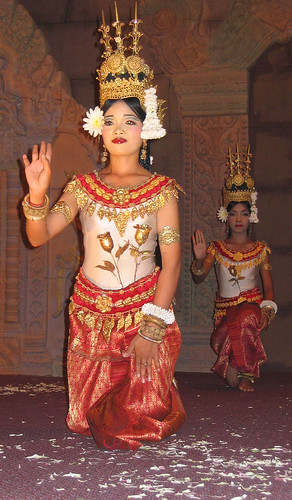Images of Apsaras are found in several temples of ancient Java dating from the era of the Sailendra dynasty to that of the Majapahit empire. Usually they are not found as decorative motifs but as integral parts of a story in bas-relief, as for example at Borobudur, Mendut, Prambanan, Plaosan, and Penataran. At Borobudur apsaras are depicted as divinely beautiful celestial maidens, pictured either in standing or in flying positions, usually holding lotus blossoms, spreading flower petals, or waving celestial clothes as if they were wings enabling them to fly. The temple of Mendut near Borobudur depicted groups of devatas, divine beings flying in heaven, which included apsaras.
Apsaras represent an important motif in the stone bas-reliefs of the Angkorian temples in Cambodia. Descriptions of the temples often distinguish between two types of depictions of female celestials: depictions of figures who are dancing or are poised to dance, which are called "Apsaras;" and depictions of figures who are standing still, facing forward, in the manner of temple guardians or custodians, which are called "Devatas."
In javanese tradition, apsara describes as the divinely beautiful celestial maidens live in Indra's heaven, and known for their special assingments by Indra to seduce ascetics who may become more powerful than the gods.
http://en.wikipedia.org/wiki/Apsara















No hay comentarios:
Publicar un comentario